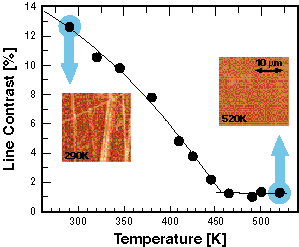
First X-Ray Microscope Images with
Clear Antiferromagnetic Contrast
Antiferromagnetic films are key players in the magnetics industry, where they are already incorporated into state-of-the-art data storage systems and are under study for future random-access computer memories that won't lose information when the power is off (nonvolatile memory). Unfortunately, the techniques that are well established for investigating the magnetic structure of ferromagnetic thin films and surfaces do not work with antiferromagnets, making these materials hard to study in detail. A group of scientists working at the ALS, however, has succeeded in obtaining high-resolution images with antiferromagnetic contrast.
|
Researchers from the IBM Almaden Research Center, the ALS, Stanford University, and Arizona State University have used the new PEEM2 photoemission electron microscope at the ALS together with the technique of x-ray magnetic linear dichroism (XMLD) spectromicroscopy to overcome this obstacle. In tests with films of nickel oxide, they recorded the first images by any technique showing unambiguous antiferromagnetic contrast on a thin-film surface. 
The images of nickel oxide they obtained exhibited bright lines with typical widths from 400 to 2000 nm (left), indicating that the average antiferromagnetism in the stripes was different from that in the dark background. With a spatial resolution of 50 nm, however, the PEEM2 could not resolve individual antiferromagnetic domains, which were estimated to be smaller than this. In one of several additional tests the researchers conducted to confirm that the image contrast was due to the antiferromagnetic structure of the sample, the visually observable contrast between the stripes and the background disappeared (right) as the temperature of the samples approached the Néel temperature, above which antiferromagnetism disappears. |
Advancing Magnetic Data Storage |
Research conducted by J. Stöhr and J. Lüning (IBM Almaden Research Center); A. Scholl, S. Anders, and H. A. Padmore (ALS); T. J. Regan, and R. L. White (Stanford University); and M. R. Scheinfein (Arizona State University. Funding: U. S. Department of Energy; Office of Basic Energy Sciences; Stanford University Center for Materials Research; and the International Disk Drive Equipment and Materials Association. Publication about this experiment: J. Stöhr et al, Phys. Rev. Lett. 83, 1862 (1999). |
|
More ALS Science